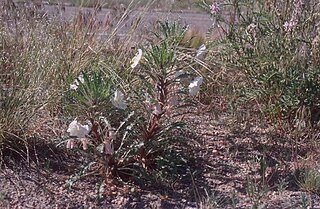
William Henry Harvey, FRS FLS was an Irish botanist and phycologist who specialised in algae.

Alice Eastwood was a Canadian American botanist. She is credited with building the botanical collection at the California Academy of Sciences in San Francisco. She published over 310 scientific articles and authored 395 land plant species names, the fourth-highest number of such names authored by any female scientist. There are seventeen currently recognized species named for her, as well as the genera Eastwoodia and Aliciella.

Nikolai Stepanovich Turczaninow was a Russian botanist and plant collector who first identified several genera, and many species, of plants.

Paul Carpenter Standley was an American botanist known for his work on neotropical plants.
George Maxwell (1804–1880) was a professional collector of plants and insects in Southwest Australia. The botanical specimens he obtained were used to make formal descriptions of the region's plant species.

The flora of Western Australia comprises 10,842 published native vascular plant species and a further 1,030 unpublished species. They occur within 1,543 genera from 211 families; there are also 1,335 naturalised alien or invasive plant species more commonly known as weeds. There are an estimated 150,000 cryptogam species or nonvascular plants which include lichens, and fungi although only 1,786 species have been published, with 948 algae and 672 lichen the majority.

Oenothera harringtonii is a species of flowering plant in the evening primrose family known by the common names Arkansas Valley evening primrose and Colorado Springs evening primrose. It is endemic to the state of Colorado in the United States. It is named for the botanist Harold Harrington.

Rose Eudora Collom was an American botanist and plant collector. She was the first paid botanist of the Grand Canyon National Park. She discovered several plant species, some of which were named in her honor, and collected numerous plant specimens.

Wilhelm Nikolaus Suksdorf was an American botanist who specialized in the flora of the Pacific Northwest. He was largely self-taught and is considered one of the top three self-taught botanists of his era for the Pacific Northwest, alongside Thomas Jefferson Howell and William Conklin Cusick.

Aven Nelson was an American botanist who specialized in plants of the Rocky Mountains. He was one of the founding professors of the University of Wyoming, where he taught for 55 years as professor and served as president (1918-1922). He served as president of the American Society of Plant Taxonomists and Botanical Society of America.

George Everett Osterhout was an American businessman and botanist. A Pennsylvania native, he later moved to Colorado and became known for his research into the flora of the Rocky Mountains. The standard author abbreviation Osterh. is used to indicate this person as the author when citing a botanical name.

Penstemon harringtonii, commonly known as Harrington's penstemon and Harrington's beardtongue, is a species of flowering plant. P. harringtonii is narrowly endemic to northwestern and north-central Colorado in the United States. It generally populates sandy soil in the arid sagebrush steppe environment. The plant blooms between June and July with pink, blue, and purple flowers. The species is named for Colorado botanist Harold Harrington.
Thomas Bernard Croat is an American botanist and plant collector, noteworthy as one of botanical history's "most prolific plant collectors". He has collected and described numerous species of plants, particularly in the family Araceae, in his career at the Missouri Botanical Garden.
Warren Lambert Wagner is an American botanist, a curator of botany, and a leading expert on Onagraceae and plants of the Pacific Islands, especially plants of the Hawaiian Islands.

Cirsium funkiae, the funky thistle or Funk's thistle, is a species of thistle found in the United States. It was first described by American botanist Jennifer Ackerfield in 2022.

Penstemon whippleanus, commonly known as dusky penstemon, dusky beardtongue, Whipple's penstemon, or Whipple's beardtongue, is a summer blooming perennial flower in the large Penstemon genus. It is a widespread plant within the hemiboreal forests of the Rocky Mountains in North America. It is noted for the large deep purple-red flowers and a preference for high mountain elevations.

Penstemon secundiflorus, commonly known as sidebells penstemon, or orchid beardtoungue is a species of Penstemon that grows in dry forests, high plains, and scrub lands from Wyoming to Mexico. It is a herbaceous perennial plant that typically grows to a height of 20 to 50 cm and has narrow, lance-shaped leaves that are grayish-green in color. The flowers of the sidebells penstemon are tubular in shape and are arranged in a one-sided spike, with the blooms all facing the same direction, and for this reason was named "secundiflorus", which means "one-sided flowers". The flowers are most often delicate shades of orchid or lavender. It is sometimes used in xeriscaping, rock gardens, and wildflower meadows, and is well-suited to dry, sunny locations with well-draining soil.

Penstemon ambiguus, commonly known as the bush penstemon, pink plains penstemon, or gilia beardtongue is a species of Penstemon that grows in the shortgrass prairies and deserts of the western United States and northern Mexico. This bush-like penstemon grows in sandy, loose, and creosote soils and is particularly known for the spectacular flowering show it produces, sometime seasons turning whole hillsides bright pink–white.

Penstemon auriberbis, commonly known as the Colorado penstemon or Colorado beardtongue, is a species of Penstemon that grows in the shortgrass prairies of southern Colorado and in a few places in northern New Mexico. Although specimens were collected on the 1820 expedition by Stephen H. Long through the area, they were not scientifically described as a separate species until 1920.

Penstemon cyathophorus, commonly known as cupped penstemon or Middle Park penstemon, is a species of flowering plant that grows in a small area in the mountains of northern Colorado and a smaller area of southern Wyoming. As a rare species with a limited range it is vulnerable to human development. It is not a large plant and is often found growing amid sagebrush plants in mountain basins and valleys.

















